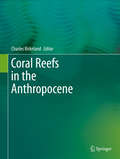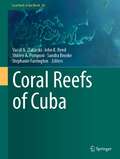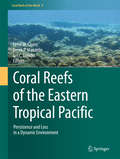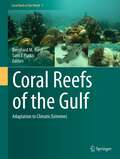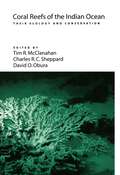- Table View
- List View
Coral Reefs in the Anthropocene
by Charles BirkelandThis volume investigates the effects of human activities on coral reefs, which provide important life-supporting systems to surrounding natural and human communities. It examines the self-reinforcing ecological, economic and technological mechanisms that degrade coral reef ecosystems around the world.Topics include reefs and limestones in Earth history; the interactions between corals and their symbiotic algae; diseases of coral reef organisms; the complex triangle between reef fishes, seaweeds and corals; coral disturbance and recovery in a changing world.In addition, the authors take key recent advances in DNA studies into account which provides new insights into the population biology, patterns of species distributions, recent evolution and vulnerabilities to environmental stresses. These DNA analyses also provide new understandings of the limitations of coral responses and scales of management necessary to sustain coral reefs in their present states. Coral reefs have been essential sources of food, income and resources to humans for millennia. This book details the delicate balance that exists within these ecosystems at all scales, from geologic time to cellular interactions and explores how recent global and local changes influence this relationship. It will serve as an indispensable resource for all those interested in learning how human activities have affected this vital ecosystem around the world.
Coral Reefs of Cuba (Coral Reefs of the World #18)
by Vassil N. Zlatarski John K. Reed Shirley A. Pomponi Sandra Brooke Stephanie FarringtonThis comprehensive volume gathers foremost experts on the coral reefs of Cuba who represent a spectrum of disciplines, including biology, conservation ecology, economics and geology. The volume is organized along general themes including the Cuban Reef biota, reefs occurring in the Mesophotic and Eutrophic zones, ecology, conservation, management and the economic importance of the coral reefs of Cuba. The combination of case studies, new and previously published research, historical overview and examples of the ways in which research has contributed to the management and conservation of Cuban coastal resources provides a unique reference for graduate students and professionals holding a wide range of interests and expertise related to coral reef systems.
Coral Reefs of the Eastern Tropical Pacific: Persistence and Loss in a Dynamic Environment (Coral Reefs of the World #8)
by Peter W. Glynn Derek P. Manzello Ian C. EnochsThis book documents and examines the state of health of coral reefs in the eastern tropical Pacific region. It touches on the occurrence of coral reefs in the waters of surrounding countries, and it explores their biogeography, biodiversity and condition relative to the El Niño southern oscillation and human impacts. Additionally contained within is a field that presents information on many of the species presented in the preceding chapters.
Coral Reefs of the Gulf: Adaptation to Climatic Extremes (Coral Reefs of the World #3)
by Bernhard M. Riegl and Sam J. PurkisCoral Reefs of the Gulf: Adaptation to Climatic Extremes is a complete review and reference for scientists, engineers and students concerned with the geology, biology or engineering aspects of coral reefs in the Middle East. It provides for the first time a complete review of both the geology and biology of all extant coral areas in the Gulf, the water body between Iran and the Arabian Peninsula. In summer, this area is the hottest sea with abundant coral growth on earth and already today exhibits a temperature that is predicted to occur across the topical ocean in 2100. Thus, by studying the Gulf today, much can be learned about tomorrow’s world and the capability of coral reefs to adapt to climatic extremes. This volume provides the most authoritative and up-to-date review of the coral reefs in the Gulf. It can be used as a volume of general reference or as a textbook treating recent coral reefs. Written by local and international experts, the text is richly illustrated and will remain a standard reference for the region for decades to come. Contributions stretch from climatology through geology, biology, ecological modelling and fisheries science to practical conservation aspects. The book is useful for the technical expert and casual reader alike.
Coral Reefs of the Indian Ocean: Their Ecology and Conservation
by T. R. McClanahan C. R. C. Sheppard D. O. OburaCoral reefs are among Earth's most diverse, productive, and beautiful ecosystems, but until recently, their ecology and the means to manage them have been poorly understood and documented. In response to the inadequate information base for coral reefs, this book reviews the ecological and conservation status of coral reefs of the Western Indian Ocean, bringing together presentations of the region's leading scientists and managers working on coral reefs. Coral Reefs of the Indian Ocean: Their Ecology and Conservation starts with a general overview of the biogeography of the region and a historical account of attempts to conserve this ecosystem. It goes on to describe the state of the reefs in each of the countries with coral reefs, and it concludes with a series of management case studies. The book also summarizes most of the existing ecological information on reefs in this region and efforts at management, making it useful for students, teachers, and investigators interested in tropical or marine ecology, conservation biology and management, and environmental sciences.
Coral Reefs of the Red Sea (Coral Reefs of the World #11)
by Christian R. Voolstra Michael L. BerumenThis volume is a complete review and reference work for scientists, engineers, and students concerned with coral reefs in the Red Sea. It provides an up-to-date review on the geology, ecology, and physiology of coral reef ecosystems in the Red Sea, including data from most recent molecular studies. The Red Sea harbours a set of unique ecological characteristics, such as high temperature, high alkalinity, and high salinity, in a quasi-isolated environment. This makes it a perfect laboratory to study and understand adaptation in regard to the impact of climate change on marine ecosystems. This book can be used as a general reference, guide, or textbook.
Coral Reefs of the United Kingdom Overseas Territories (Coral Reefs of the World)
by Charles R.C. SheppardThe tropical UK Territories have extensive coral reefs. Huge parts of these areas are exceptionally rich, productive and diverse. Their marine biodiversity exceeds that of the UK itself, and several are already, or are planned to be, strictly protected. Some of these areas serve as reference sites for many other countries with damaged reefs and they are oases of tropical marine biodiversity in a fast-degrading world. This book reviews all of the UK reefs, from those scarcely known to those where substantial research has already been performed.
Coral Reefs of the USA (Coral Reefs of the World #1)
by Bernhard M. Riegl Richard E. DodgeCoral Reefs of the USA provides a complete overview of the present status of knowledge regarding all coral reef areas within the USA and its territories. It is written by the most experienced authorities in their fields and geographic areas. Stretching from the Caribbean to the western Pacific, the coral reefs of the USA span extensive geographic and biotic diversity, occur in a wide variety of geomorphological settings, and provide a representative cross-section of Holocene reef-building. This book will therefore be of broad general interest. For the first time, complete scholarly reviews are given for the geology, geomorphology and the biology of reefs encompassing a vast area stretching from the Mariana Islands in the west, Samoa in the south, Hawaii in the north and the Virgin Islands in the east. This book is not a status report, but will provide up-to-date information about stressors and the biotic responses of the reefs, as well as the geological explanations why these reefs exist in the first place. It will be an invaluable baseline-reference for all those who are engaged in research or management of these coral reefs or to those who simply enjoy being well-informed about one of the most iconic ecosystems of the USA.
Core Electrodynamics (Undergraduate Lecture Notes in Physics)
by Sandra ChapmanThis book is intended to engage the students in the elegance of electrodynamics and special relativity, whilst giving them the tools to begin graduate study. Here, from the basis of experiment, the authors first derive the Maxwell equations and special relativity. Introducing the mathematical framework of generalized tensors, the laws of mechanics, Lorentz force and the Maxwell equations are then cast in manifestly covariant form. This provides the basis for graduate study in field theory, high energy astrophysics, general relativity and quantum electrodynamics. As the title suggests, this book is “electrodynamics lite”. The journey through electrodynamics is kept as brief as possible, with minimal diversion into details, so that the elegance of the theory can be appreciated in a holistic way. It is written in an informal style and has few prerequisites; the derivation of the Maxwell equations and their consequences is dealt with in the first chapter. Chapter 2 is devoted to conservation equations in tensor formulation; here, Cartesian tensors are introduced. Special relativity and its consequences for electrodynamics are introduced in Chapter 3 and cast in four-vector form, and here, the authors introduce generalized tensors. Finally, in Chapter 4, Lorentz frame invariant electrodynamics is developed. Supplementary material and examples are provided by the two sets of problems. The first is revision of undergraduate electromagnetism, to expand on the material in the first chapter. The second is more advanced corresponding to the remaining chapters, and its purpose is twofold: to expand on points that are important, but not essential, to derivation of manifestly covariant electrodynamics, and to provide examples of manipulation of cartesian and generalized tensors. As these problems introduce material not covered in the text, they are accompanied by full worked solutions. The philosophy here is to facilitate learning by problem solving, as well as by studying the text. Extensive appendices for vector relations, unit conversion and so forth are given with graduate study in mind.
Core-Mantle Co-Evolution: An Interdisciplinary Approach (Geophysical Monograph Series)
by Takashi Nakagawa Taku Tsuchiya Madhusoodhan Satish-Kumar George HelffrichCore-Mantle Co-Evolution An Interdisciplinary Approach The Earth’s deep interior is difficult to study directly but recent technological advances have enabled new observations, experiments, analysis, and simulations to better understand deep Earth processes. Core-Mantle Co-Evolution: An Interdisciplinary Approach seeks to address some of the major unsolved issues around the core-mantle interaction and co-evolution. It provides the latest insights into dynamics, structure, and evolution in the core-mantle boundary region. Volume highlights include: Latest technological advances in high pressure experiments and their application to understanding the mineral physical properties and stability of phases in deep Earth Recent progress in observational seismology, geochemical analysis, geoneutrino experiments, and numerical modeling for understanding the heterogeneity of the lower mantle Theoretical investigations on thermal-chemical evolution of Earth’s mantle and core Exploring thermal-chemical-mechanical-electromagnetic interactions in the core-mantle boundary regions The American Geophysical Union promotes discovery in Earth and space science for the benefit of humanity. Its publications disseminate scientific knowledge and provide resources for researchers, students, and professionals.
Core-Mantle Co-Evolution: An Interdisciplinary Approach (Geophysical Monograph Series)
by Takashi Nakagawa Taku Tsuchiya Madhusoodhan Satish‐Kumar George HelffrichCore-Mantle Co-Evolution An Interdisciplinary Approach The Earth’s deep interior is difficult to study directly but recent technological advances have enabled new observations, experiments, analysis, and simulations to better understand deep Earth processes. Core-Mantle Co-Evolution: An Interdisciplinary Approach seeks to address some of the major unsolved issues around the core-mantle interaction and co-evolution. It provides the latest insights into dynamics, structure, and evolution in the core-mantle boundary region. Volume highlights include: Latest technological advances in high pressure experiments and their application to understanding the mineral physical properties and stability of phases in deep Earth Recent progress in observational seismology, geochemical analysis, geoneutrino experiments, and numerical modeling for understanding the heterogeneity of the lower mantle Theoretical investigations on thermal-chemical evolution of Earth’s mantle and core Exploring thermal-chemical-mechanical-electromagnetic interactions in the core-mantle boundary regions The American Geophysical Union promotes discovery in Earth and space science for the benefit of humanity. Its publications disseminate scientific knowledge and provide resources for researchers, students, and professionals.
Coring Methods and Systems
by Rahman Ashena Gerhard ThonhauserThis book is a practical guide to downhole rock sampling and coring concepts, methods, systems, and procedures for practitioners and researchers. Its chapters are based upon years of extensive studies and research about the coring methods and via direct and continuous communication and consultation obtained from various service and operator companies such as Baker Hughes GE, NOV, OMV, and Sandvik. The contributors discuss the state-of-the-art coring methods and systems (mainly used in the petroleum industry), which include: · conventional coring; · wireline continuous coring; · invasion mitigation coring (low invasion, gel coring, sponge coring); · jam-detection, anti-jamming, full closure; · safe-coring and tripping; · oriented-coring; · pressure/in-situ coring; · logging-while-coring; · motor coring; · mini-coring; · coiled Tubing Coring; and · underbalanced coring. The contributors provide practical and applicable understanding of the procedures of these coring methods and systems, as well as the specific core barrel components, working mechanisms, and schematics of the tools and processes used. Because Coring Methods and Systems analyses and compares the core barrels used in both petroleum and mining industries, it enhances the communication and may allow knowledge transfer between the two industries. As core damage is a serious issue during coring and handling jeopardizing correct calibration of exploration data, Coring Methods and Systems has greatly focused on its identification and its mitigation. Therefore, it can be used as an ideal source for geologists, core analysts, and reservoir engineers, to ensure the retrieval of high-quality cores.
Coring Operations: Procedures for Sampling and Analysis of Bottomhole and Sidewell Cores (Exlog Series of Petroleum Geology and Engineering Handbooks)
by EXLOG/WhittakerThis coring operations reference handbook is intended as a practical guide for the logging geologist to procedures, activities, and responsibilities required when bottomhole or sidewall coring is performed at the wellsite. Not all of the operations described are common practice in all logging units; however, familiarity with them is a necessary part of general ex ploration knowledge and professionalism. Chapter 1 discusses the concepts of porosity, permeability, and saturation, how these properties are determined in core analysis, and their significance in controlling rest:rvoir performance. Chapter 2 deals with the various techniques used in coring. Chapter 3 ex plains the routine role of the logging geologist in core retrieval, sampling, and qualitative evaluation. Chapter 4 details operating procedures for quantitative wellsite core analysis equipment. 1 INTRODUCTION 1. 1 GENERAL 1. 2 QUANTITATIVE CORE ANALYSIS The primary purpose of coring is to obtain rock samples of a sufficient size to obtain estimates of critical reservoir properties.
The Cornerstone of Development: Integrating Environmental, Social, and Economic Policies
by Jamie Schnurr 0 Idrc Susan Holtz Greg Armstrong Anne K Bernard"Sustainable development" quickly became the universal goal for environmentalists in the 1990s, motivated by the 1988 Brundtland Report and the 1992 Earth Summit in Rio. When the time came to bring theory into reality, sustainable development revealed far more complexity than first anticipated.To attain sustainable development in the full sense of the phrase"meeting present needs without compromising the resources needed for future societies"environmental and social concerns would need a constant presence in all major economic decisions.The Cornerstone of Development: Balancing Environmental, Social, and Economic Imperatives profiles many of the first attempts to implement sustainable development initiatives worldwide. The model: Canada's experience with "multistakeholder" decision-making. Under the guidance of Canada's National Task Force on Environment and Economy, nationwide and provincial round tables brought government officials together with corporate officers to formulate sustainable development guidelines.Authorized by the Canadian government to serve as an "Agenda 21 organization," the International Development Research Centre (IDRC) subsequently researched the feasibility of adapting the multistakeholder approach to the needs and practices of developing countries. The results are in these pages: valuable case histories from Africa, Latin America, Asia and Canada, each recounting the risks and benefits from integrating environmental, social and economic policies.When IDRC members were asked for ways to address environmental sustainability, they had few examples to follow"and little evidence that such endeavors could be fulfilled. The research and problem-solving efforts they produced are now collected here, for the guidance of other environment/development balance programs worldwide.
The Cornerstone of Development: Integrating Environmental, Social, and Economic Policies
by Jamie Schnurr 0 Idrc Susan Holtz Greg Armstrong Anne K Bernard"Sustainable development" quickly became the universal goal for environmentalists in the 1990s, motivated by the 1988 Brundtland Report and the 1992 Earth Summit in Rio. When the time came to bring theory into reality, sustainable development revealed far more complexity than first anticipated.To attain sustainable development in the full sense of the phrase"meeting present needs without compromising the resources needed for future societies"environmental and social concerns would need a constant presence in all major economic decisions.The Cornerstone of Development: Balancing Environmental, Social, and Economic Imperatives profiles many of the first attempts to implement sustainable development initiatives worldwide. The model: Canada's experience with "multistakeholder" decision-making. Under the guidance of Canada's National Task Force on Environment and Economy, nationwide and provincial round tables brought government officials together with corporate officers to formulate sustainable development guidelines.Authorized by the Canadian government to serve as an "Agenda 21 organization," the International Development Research Centre (IDRC) subsequently researched the feasibility of adapting the multistakeholder approach to the needs and practices of developing countries. The results are in these pages: valuable case histories from Africa, Latin America, Asia and Canada, each recounting the risks and benefits from integrating environmental, social and economic policies.When IDRC members were asked for ways to address environmental sustainability, they had few examples to follow"and little evidence that such endeavors could be fulfilled. The research and problem-solving efforts they produced are now collected here, for the guidance of other environment/development balance programs worldwide.
Cornerstones: Wild forces that can change our world
by Benedict MacdonaldBY THE WAINWRIGHT-CONSERVATION-PRIZE-WINNING AUTHOR OF REBIRDING Transform your understanding of the natural world forever and discover the wild forces that once supported Britain's extraordinary natural riches, and could again.Our precious archipelago is ravaged by climate change, bereft of natural ecosystems and lies at the mercy of global warming, flooding, drought and catastrophic biodiversity loss. But could restoring species that once helped protect our islands help turn this crisis around?From familiar yet imperilled honeybees and ancient oak woods to returning natives like beavers and boars, Britain's cornerstone species may hold the key to recovering our biodiversity on land and in our seas. In Cornerstones, we discover how beavers craft wetlands, save fish, encourage otters, and prevent rivers from flooding. We learn how 'disruptive' boars are seasoned butterfly conservationists, why whales are crucial for restoring seabird cities and how wolves and lynx could save our trees, help sequester carbon and protect our most threatened birds.Benedict Macdonald transforms our understanding of the natural world forever, revealing lives that once supported extraordinary natural riches and explaining how humans – the most important cornerstone species of all – can become the greatest stewards of the natural world.
Cornish Clouds and Silver Lining Skies: Your no. 1 sunny, feel-good read for the summer
by Ali McNamaraMeteorologist Sky Matthews does not like surprises.Sky monitors her life like she does the weather, carefully and with a scientific eye. So, when she misses out on her dream job abroad and finds herself with no choice but to take a position on a tidal island off the Cornish harbour town of St Felix instead, she feels completely at sea. Worse still, she has to work alongside TV weatherman Sonny Samuels, who barely knows his storms from his tsunamis.It doesn't take long for Sky to become enchanted by the strange weather patterns over St Felix. Sonny is convinced they link to local folklore, but Sky knows her science too well to fall for that. Until she meets Walter, a local weather watcher with no qualifications beyond a lifetime of experience and Sky is forced to question everything she thought she knew about the weather, herself... and Sonny._______________Praise for Ali McNamara:An enchanting escape. Pure magic!' Heidi Swain'A perfect, sparkling, summer read.' Cathy Bramley'Fun and endearing' Katie Fforde'Perfect easy reading' SunAn irresistible, feel-good story infused with infectious humour' Miranda Dickinson'Funny and light-hearted' Heat
Coronal Expansion and Solar Wind (Physics and Chemistry in Space #5)
by A. J. HundhausenLittle more than ten years have passed since spaceprobe-borne instruments con clusively demonstrated the existence of the solar wind. These observations con firmed the basic validity of a theoretical model, first proposed by E. N. Parker, predicting a continuous, rapid expansion of the solar corona. The subsequent decade has seen a tremendous growth in both the breadth and sophistication of solar wind observations; the properties of the interplanetary plasma near the orbit of the earth are now known in great detail. The theory of the coronal ex pansion has also been highly refilled both in the sense of including additional physical processes, and of treating more realistic (time-dependent and non spheri cally-symmetric) coronal boundary conditions. The present volume is an attempt to synthesize the solar wind observations and coronal expansion models from this decade of rapid development. The ultimate goal is, of course, the interpretation of observed solar wind phenomena as the effects of basic physical processes occurring in the coronal and interplanetary plasma and as the natural manifestations of solar properties and structures. This approach implies an emphasis upon the "large-scale" features revealed by the observations. It requires extensive use of the concepts and methods of fluid mechanics.
Coronal Magnetometry
by Steven Tomczyk Jie Zhang Timothy BastianCaptures advances being made in the field of coronal magnetism, from theory to observations and instrumentation.This volume is a collection of research articles on the subject of the solar corona, and particularly, coronal magnetism. The book was motivated by the Workshop on Coronal Magnetism: Connecting Models to Data and the Corona to the Earth, which was held 21 - 23 May 2012 in Boulder, Colorado, USA. This workshop was attended by approximately 60 researchers. Articles from this meeting are contained in this topical issue, but the topical issue also contains contributions from researchers not present at the workshop.This volume is aimed at researchers and graduate students active in solar physics.Originally published in Solar Physics, Vol. 288, Issue 2, 2013 and Vol. 289, Issue 8, 2014.
The Coronas-F Space Mission: Key Results for Solar Terrestrial Physics (Astrophysics and Space Science Library #400)
by Vladimir KuznetsovThis volume is the updated and extended translation of the Russian original. It presents the results of observations of solar activity and its effects in the Earth space environment carried out from July 2001 to December 2005 on board the CORONAS-F space mission. The general characteristics of the CORONAS-F scientific payload are provided with a description of the principal experiments. The main results focus on the global oscillations of the Sun (p-modes), solar corona, solar flares, solar cosmic rays, Earth’s radiation belts, and upper atmosphere. The book will be welcomed by students, post-graduates, and scientists working in the field of solar and solar-terrestrial physics.This English edition is supplemented by sections presenting new results of the SPIRIT and TESIS experiments under the CORONAS solar program, as well as from the SONG experiment onboard the CORONAS-F satellite.
Corporate Approaches to Sustainable Development: International Experiences and Insights (Science for Sustainable Societies)
by Isabel B. FrancoThis book aims to answer the question: how can the industry action international approaches to corporate sustainability, ultimately achieving sustainable development and overall sustainability? With this question in mind, this manuscript examines how the industry, through existing approaches to corporate sustainability, contribute to addressing conflicting demands emerging from the achievement of sustainable development in a responsible, sustainable and innovative manner. It also reviews alternative models of corporate sustainability that contribute to achieving inclusive, sustainable development globally. Chapters 2 to 4 discuss emerging approaches to corporate sustainability. Chapters 5 to 11 examine the role that the extractive industry (mining and oil) could play in the delivery of sustainable solutions for the communities and environment in selected cases, in the Americas and Africa. Lastly, the manuscript showcases international corporate sustainability and climate change practices in the forestry, agriculture, tourism and manufacturing industries within the context of Asia and The Pacific region, particularly, Nepal and Bangladesh.
Corporate Biodiversity Management for Sustainable Growth: Assessment of Policies and Action Plans (Environment & Policy #59)
by Ravi Sharma Aparna Watve Amitabh PandeyThis book aims to cover the multitude of corporate approaches towards mainstreaming biodiversity conservation and ecological management in policies and action plans, and explores the roles of these efforts in achieving national and global targets for the Sustainable Development Goals (SDGs). The book addresses various aspects of corporate actions such as corporate environmental responsibility, green businesses, market-based approaches to biodiversity conservation, and biodiversity trade-offs, and includes concept papers, reviews, and case studies presenting qualitative and quantitative research. Additionally, the text compares and assesses examples of positive and negative impacts of corporate involvement in biodiversity conservation in developed and developing countries to identify innovative approaches, and the best practices and models that can be replicated in diverse environmental conditions. The studies included in the book will help those working in the field of corporate involvement in biodiversity conservation, and outline the strengths and weaknesses of the approaches which will be useful for designing new environmental management action plans in the face of climate change. The book will also be of great value to researchers, academicians, policy makers, civil society groups, policy think tanks, and conservation managers.
Corporate Carbon and Climate Accounting
by Stefan Schaltegger Dimitar Zvezdov Igor Alvarez Etxeberria Maria Csutora Edeltraud GüntherThis volume is devoted to management accounting approaches for analyzing business benefits and costs of climate change. It discusses future directions on carbon accounting, performance measurement and reporting as well as links between climate accounting and business processes, product and service development, supply chain innovation, economic successes and stakeholder relations.Companies are increasingly called on to contribute to combatting climate change and also face the challenges presented by climate-change related costs, risks and benefits. Risks can result from unpredictable weather conditions and government regulations, such as the EU emission trading system and new building codes. Climate change also offers numerous opportunities, such as energy efficiency innovations and carbon neutral products and production.Good management requires that carbon emissions are tracked and climate-related costs, risks and benefits are identified, measured and assessed. As such, research addressing corporate accounting frameworks and tools is of increasing importance when it comes to managing these carbon and climate-related issues.
Corporate Citizenship: Business and Society in Botswana
by France Maphosa Langtone MaunganidzeThis book discusses corporate citizenship, corporate responsibility and business ethics across Africa generally, and Botswana specifically. It begins by contextualizing Botswana within the broader context of Africa, using nine other countries – Angola, Cameroon, Ghana, Kenya, Nigeria, South Africa, Zambia and Zimbabwe – to provide a comparative perspective, examining the common factor: that weak legalization makes it challenging for corporate social responsibility to be actualized.From this background, the book then discusses Botswana as a key study. Botswana has been described as ‘Africa’s economic miracle’ due to its growing economy since independence This puts it in a unique position for the implementation and study of corporate social responsibility. The interdisciplinary team of authors employ various research methods to examine the complex relationship between business, society, corporations and social justice issues.This book will be valuable reading for any academic working on corporate social responsibility in Africa, and will present an interesting insight to an often neglected area of study. France Maphosa is a Professor of Sociology at the University of Botswana. His research interests include migration and transnationalism, the sociology of entrepreneurship, corporate social responsibility, urban and rural livelihoods, labour studies and alternative dispute resolution (ADR).Langtone Maunganidze is a Senior Lecturer in the Faculty of Social Sciences at the Midlands State University in Zimbabwe. His research interests include industrial sociology, business and society, rural livelihoods and sustainable development, and entrepreneurship.
Corporate Citizenship and Family Business (Citizenship and Sustainability in Organizations)
by Claire SeamanCurrent models of corporate citizenship largely consider business as one coherent entity. This view of business as a corporate force overlooks the growing evidence that most businesses are run by families. Family businesses are the most common form of business in existence – across countries, continents and geopolitical divides – and yet we know remarkably little about their approach to corporate citizenship. Where families run businesses, they create a concentration of family values that – for good or ill – influence the way business practices and behaviours develop. The role of the family in business has, therefore, an influence on the development of society that is partially mediated through corporate citizenship. This book pulls together current thinking from several diverse research fields that intersect with family business research to offer insight into current research and examples of practice for those studying and researching in the fields of family business, business values and corporate practice. The book will also explore the fact that family businesses tend to take a longer-term approach to business and that this is reflected in their behaviour towards the environment, community engagement, employee development and innovation. Bringing together contributions from researchers in the diverse fields of family business, philanthropy, community engagement, corporate social responsibility, innovation and policy, this book explores the many ways in which family businesses contribute to the corporate citizenship agenda.
